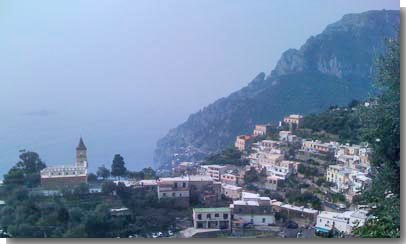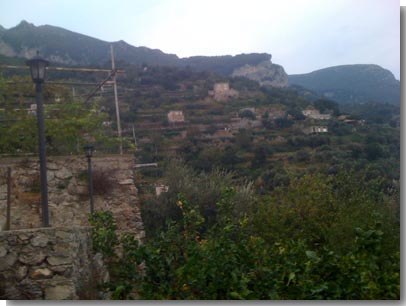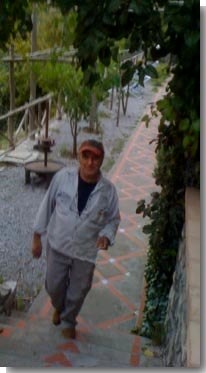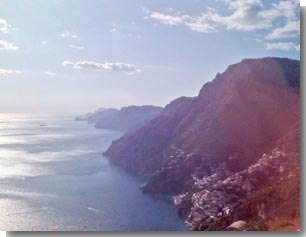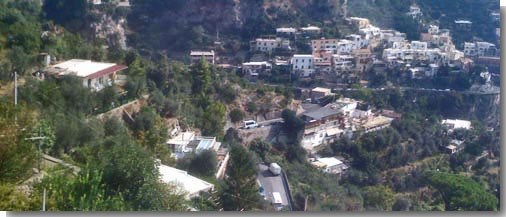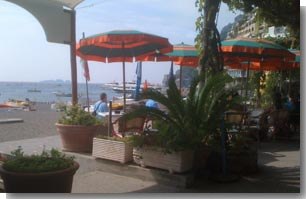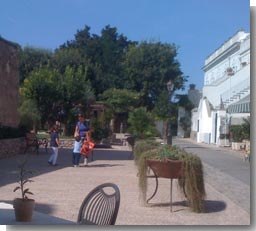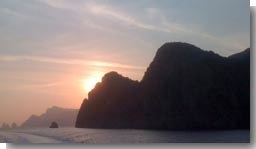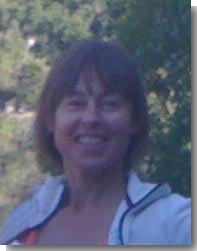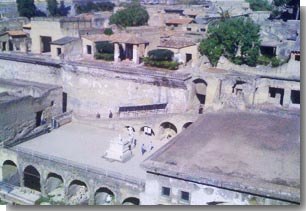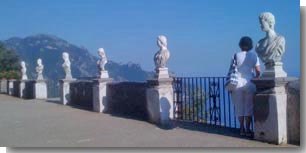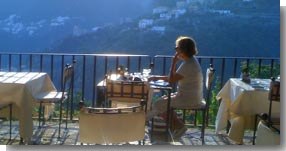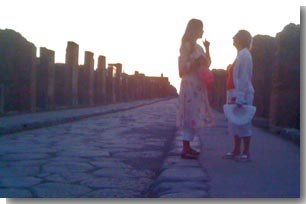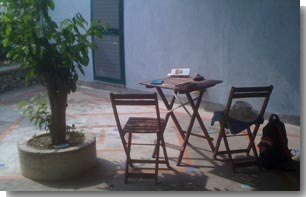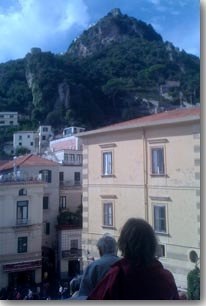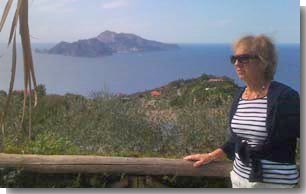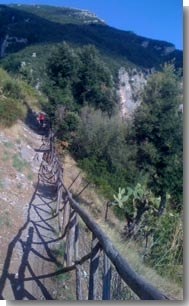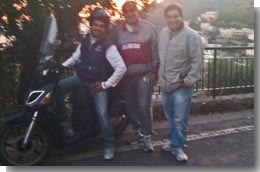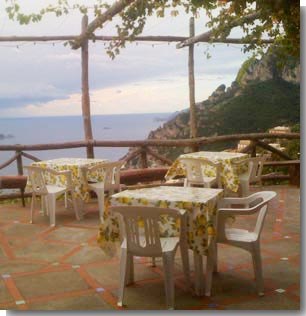An Enchanted October
MONDAY, 26 September 2011
The last B&B guests leave Arden House on Monday morning. I bank the cash, put out the rubbish, parcel up the perishable food for Lynn Amanda and Christine next door, go over the holiday checklist one more time. We always forget something. What would it be this time? Opening the conservatory rooflights? Turning down the central heating? This time it is the hall lights. We always leave the hall lights on dimly overnight to help guests find their way to bed after a late night out. So the burglars know the house is occupied when the lights are on. This time we forget to turn on the hall lights.
Bus to Southampton. Train to Gatwick. We stay overnight in the Hilton ready for an early plane to Naples. In the Hilton our waitress Aleksandra tells us her flatmate Magdalena once taught English in Bielsko Biała years ago, perhaps alongside Caroline?
TUESDAY
Doors to manual. Naples air is not too hot, just dry and pleasant. Off we go towards Sorrento in a hired Fiat Panda. Lunch at a pizzeria in Vico Equense with a view of the Bay of Naples and Vesuvius. At the pretty small town of Meta we take the high road over the pass through the Monte Lattari - Milky Mountains - and then suddenly the south coast of the Sorrento peninsula is there: the islands of I Galli and Capri to the right, the Amalfi coast stretching away lazily in the sunshine to the left. Down the mountain road we traverse the cliffs, clinging to a steep edge of high limestone plunging into the sea a thousand feet below.
Every time we arrive at in a new city we pay too much for some sort of service - often the first taxi ride. This time it is an old man at the roadside with several small dogs and a fruit stall. We buy a kilo of grapes, some very large oranges and several peaches. For twenty three euros. Ridiculous, but it helps the local economy.
Just before
Positano the road narrows and descends somewhat. Here we take the first turning since the mountain pass,
up the hillside to Montepertuso. Ah, Montepertuso, to be our home village for a fortnight. This mountain road is narrow, often lined with cars on one side, overhung with rock walls to the left and stone walls to the right, winding inwards over river gorges, outwards round blind corners past rocky spurs, climbing all the while. The driving is strange to an Englishman unfamiliar with left hand drive and unused to the penalty for misjudging the width of his car: a collision with a bus or a scraped door panel surrendering the excess on his car insurance. After three or four kilometres of this we spot the small sign: Le Ghiande B&B. Time to park, gingerly as close as we dare to the light railing with its hard concrete foundation on the edge of the precipice, aiming to avoid a scrape from other cars coasting down the hill. Time to phone Salvatore Cuccaro, our host for the coming fortnight.
Fit young Antonio Barba -
Beard - bounds down the steps like Tigger to collect
i bagagli - the luggage - and we follow up to Le Ghiande. The ground is littered with acorns, walnuts, almonds, and a few olives. We are in fertile country, terraces formed to yield the most from the steep hillside.
The steps zigzag upwards: thirty-three, seven, fourteen, twenty-one, fifteen, making ninety. We had been told there would be ninety steps to climb; true. But there are another couple of turns: another twenty-five steps to the gate of the little estate and then a further seven to the breakfast terrace
and then a further twenty-seven to the level of our bedroom. Good for the heart. Here there are steps everywhere, The route from house to house, from home to shops, from village to town, is made of steps. There are two thousand steps (or so, no-one has counted) from Le Ghiande to the volcanic grey sand beaches of Positano.
Salvatore and Antonio welcome us with orange juice and cake, which Salvatore makes himself. Salvatore has a birthday just after we are due to leave: he will be twenty-nine. Antonio is his cousin, enrolled at University in Salerno, here to help during the vacation. Salvatore runs the B&B during the summer season and operates his building business in the winter. Each day at Le Ghiande we meet a new member of the family. Regina is S
alvatore’s girl friend. Carlo
is his uncle. Michaeli is Antonio’s father. Theresa is an aunt. Then there’s Agnelo, another uncle. Most of the people in Montepertuso are Cuccaros, and several of them are Salvatores. The cook who runs the nearest restaurant, two hundred feet below in the village square, is Salvatore too, but he’s not our Salvatore; he is Salvatore Barba; perhaps he’s related to Antonio? Giovanni, their old school teacher, runs a ceramic business in Positano. Everyone is very friendly. Tomorrow, plenty of the family will be here very early in the morning to spend the day gathering the ripe grapes.
Le Ghiande means The Acorns. Salvatore explains that he would have called his B&B Le Querce - the oak trees - but for the presence nearby of another B&B with that name.
The path from the gate to the terrace is lined with small tomato vines, and cherry tomatoes abound on the gravel beside the path. Eat and be filled. Our room is really an apartment: besides bedroom and bathroom, there’s a hallway, a kitchen, and a terrace leading out to a potato patch with vine-laden pergola and a view of hillside below, the sea, and the coast away to the island of Capri, whose needle rocks and highest mountain we can glimpse above the massif of the Monti Latteri.
Time to unpack, and then take
cena - dinner. Salvatore recommends
Il Ritrovo, the restaurant in the square. Paulo, the head waiter, is his good friend. We are to say we have been recommended by Salvatore Cuccaro at Le Ghiande, and thus the bill will be adjusted. It is. We are treated to complimentary glasses of Asti, then
crostini with dried tomatoes before our meal. we both chose grilled local fish - scrumptious - with desserts and coffee. The price comes to 69 euro. Paulo crosses that out, writes 60, gives us glasses of
Limoncello and with a smile a packet of dried chillies - the natural viagra, the label explains, alongside a sketch of a small priapic gentleman.
How thoughtful. I ask Paulo if he thinks I need to eat all these chillies tonight.
WEDNESDAY
Breakfast is from 7:30 till 9:30. Breakfast is coffee, orange juice, croissants, soft rolls, yoghurt, butter and jams, and home-made cake.
We eat late. This is a day to relax. The gravel beside the path has deck chairs, the sun is warm if hazy, books can be read.
Evening meal in Trattoria Tagliata, five minutes up the hill from home. This is the sort of family place where one eats what one is given: antipasti, followed by either ‘pasta’ or by ‘meat’. No bill, no credit cards; fifty euros in cash. The antipasti is a meal; then we take the pasta: cheese-filled ravioli. Excellent, so we book for Friday. Friday night at Tagliata is music night.
THURSDAY
Positano by bus. The red twelve seater shuttles between Positano and Nocelle via Montepertuso, taking half an hour in each direction.
More of Nocelle later. Positano is tourist heaven: Full of sunshine and shops: clothes and ceramics, mostly. There are street vendors. We buy a simple
necklace of bright red discs, walk past a couple of churches, down slopes of volcanic lava stones and steps (of course) to the main beach level.
Patti would like to see Capri, so we book a boat trip for Friday. Then a drink and a light lunch in a pavement café that will become our rendezvous over coming days. Shopping, then up the hill by bus. We try the other Montepertuso restaurant,
Il Scirocco, but they are full with a party so we book for Saturday instead. That means dinner at Il Ritrovo again. Same treatment, but a packet of dried leaves for use as an infusion with olive oil to be eaten with bread, instead of the natural viagra. Am I supposed to have recovered from the journey?
FRIDAY
Up early. The catamaran leaves at 10:25 so we have to be on the eight o’clock bus to be sure not to miss our trip to Capri. The boat follows the coast past I Galli, three tiny islands we first saw from the height above Sorrento. I Galli is the modern name. Otherwise they are Le Sirenuse - the home of the sirens who would lure sailors to wreck their craft on the rocks. In half an hour we are moored, mediterranean style, to the quay in the island harbour. Capri harbour is busy: boats from Sorrento, Naples and elsewhere. The island is four miles by two, but feels uncrowded despite its popularity. Apparently Gracie Fields lived here. I expect she liked shopping. This place is full of shops. I am told later that the clothes are better quality than in Positano, or in Amalfi which we do visit later in our second week.
We take the bus up the hill to
Anacapri, clean, fresh and quiet.
We find a pleasant square and eat a pizza or two. Then it’s off to find the chair lift to the mountain top. Patti goes up and admires the view. I stay below and relax in the café. Then we’re off together by bus to the main town, called Capri. Aren’t these names confusing. The north side of the town is full of alleyways, and, yes, shops. We look in lots of shops. We buy some things. Then we climb back to the top of the town and catch the Swiss-built funicular down to the port and wait for the boat to take us back to Positano on the mainland.
Dinner at Tagliata as planned. The place is heaving with Americans. It’s someone’s birthday. Happy Birthday, the singer starts up and everyone joins in. Then it’s dancing to guitar or keyboard and more of the singer. Throughout all this the family waiters negotiate the crowd loaded high with plates and glasses and drop nothing: quite a feat.
SATURDAY
Patti decides she would like a different room, one with a better view of the sea. A friendly Russian couple are due to depart that day. They come from St Petersburg and have a larger car than we do. Oligarchs? We inspect the Russians’ room, but decide to stay put.
Susie Watkins arrives.
Susie is with us for several days, appears at breakfast, engages everyone in conversation, and keeps up a steady stream of chatter for ever. Susie is a girl with experience. She is a model and an actress. She appeared as Jo Halsall in Brookside in the early nineties, had parts in other TV series including Taggart, was a photographic model, and now earns her living as a carer of old ladies - which by all accounts she does very well - two weeks on, two weeks off. When she’s off she’s off - travelling. Susie is a live wire.
Apart from chatter with Susie, Saturday is a welcome rest day.
The dinner we’d booked at Il Scirocco is not outstanding; pushy staff and mediocre food for which we pay too much. Noisy Americans, too. Don’t eat at Il Scirocco.
SUNDAY
Time to see some ruins. There are three or four accessible archaeological sites near Vesuvius. On Sunday we drive to Herculaneum - Ercolano in modern Italy. In AD 79 when the volcano exploded, Herculaneum’s 4,000 fleeing inhabitants stood no chance as the city was swamped under ten metres or so of volcanic mud. The old town was discovered by accident about two hundred years ago. By now much of it has been unearthed, revealing whole buildings intact.
After the ruins,
Vesuvio the mountain. I am confused over the presence of a funicular railway, or a chair lift, to a spot very near the crater; this turns out to be a false rumour, despite the marks on the map. We are met near the defunct funicular station by the old manager’s widow, a garrulous lady who sells us guide books and explains that her husband had been ‘the guardian of the volcano’. What will happen to Vesuvius without her guardian? The chair lift had been abandoned because of the danger from high winds; The funicular was discontinued thirty years ago. The funicular’s lower station area now has a gift shop and a coach park filled with litter. This is a national park. Why don’t they clean it up?
MONDAY
A week almost gone, and we are getting used to the place. Another rest day. Books on the terrace, which feels more and more like a quiet spot in a resort hotel, with its swimming pool replaced by terraced vineyards above the vista of the Tyrrhenian Sea, the sound of splashing children by the barking of distant dogs across the valley.
TUESDAY
Ravello. Lovely place, the best yet.
Salvatore tells us we must see the gardens of
Villa Rufolo and of
Villa Cimbrone. If we haven’t time for both, then Cimbrone.
The gardens of Villa Cimbrone
were designed by an Englishman, assisted by an Italian waiter who became his inspiration. The Englishman: Ernest Beckett,
Lord Grimthorpe, who found it “the most beautiful place in the world”. The waiter: Nicola Mansi, an eclectic, imaginative and highly inventive character.
After our garden wandering we take tea and ice creams in the afternoon - pomeriggio - on the cliff edge terrace of Hotel Villa Maria.
This trip necessitates driving along ‘the road of a thousand bends’ weaving round the cliffs high above the sea, enduring numerous traffic jams, avoiding cars overtaking dangerously close in front of oncoming buses, keeping our nerve as Vespas brush the driving mirror.
WEDNESDAY
Rest. Reading in the sunshine, in the garden beyond our private terrace.
THURSDAY
Pompeii. We take Susie. Some difficulty negotiating Torre Annunziata, but then a young lady with a baby on her left hip guides us to her car park and restaurant. We arrive just before several coach parties. They do not hold up our meal but swamp the ruins of Pompeii, distracting our contemplation of that ancient civilisation.
By late afternoon the coach parties have left and peace prevails. Susie finds a guide to show us frescoes in buildings locked against the general public. He asks no tip or fee, being simply pleased to hear and see our appreciation of the treasures in his care.
We arrive back at Le Ghinade to a limoncello welcome from Salvatore and uncle Carlo, who by then has taken a fancy to Susie. A convivial evening. Susie contemplates marrying Carlo . . . . .
FRIDAY
Another rest day in the sun. Finish one book and start another.
Bliss. Evening Meal at
Café Positano with a view of the sea.
SATURDAY
An opportunity to visit Amalfi. Why not? How could we return from the Amalfi Coast without visiting Amalfi? The town is almost worth the tortuous drive.
We start with coffee in a traditional bar on the Piazza del Duomo.
Amalfi Cathedral is certainly splendid, up only 55 steps! Emerging from the west doors as we leave the bar is a wedding party; sugared almonds fall like snow on the couple: he standing tall like Al Pacino in The Godfather, she forceful and determined. They should have an interesting time together. The interior of the cathedral, its cloister and crypt are all full of good things. We see images of St Andrew, especially in the crypt altarpiece where he stands larger than life in front of a black marble saltire, the instrument of his death.
St Andrew’s skeleton was brought here in the fifth century and bits of it are venerated in occasional ceremonies.
Out into the sunshine, lunch in a pleasant restaurant, then up the street to the paper factory museum. It seems the art of paper making was brought here by the Arabs, and from the middle ages paper was made in Amalfi. However, the museum is disappointing. Surely more could be make of this keystone activity? The town museum higher up the hill closed at three, so we miss out there.
Don’t mention the return journey. In the rush hour. The memory frightens me. Overtaken in a tunnel by Posche Carrera just making it before a lorry bears down, then a motorcyclist squeezes past. These chaps appear as though from nowhere. Must remember to keep checking that offside mirror, or I shall be up before the magistrate for knocking someone off his bike or worse.
SUNDAY
Sorrento via the coast road. Salvatore insisted that Termini and Massa Lubrense were worth the diversion and he is right. Patti spots the restaurant for lunch, high up outside Termini with a fine view of Capri.
Sorrento disappoints. Just a large town on the coast, several hundred feet above the sea and no discernible beaches. We park, walk, shop in Max Mara, visit the church of St Andrew - Italy’s patron saint - and drive away, glad eventually to rejoin our coast road at the col and cover the now familiar twits and turns to Positano and Montepertuso.
Montepertuso takes its name from the hole in the rock to the west, which can be clearly seen from Le Ghiande.
MONDAY
A short bus trip to Nocelle at the end of the road. Nocelle at first sight is a small car park with space for the bus to turn round. But as everywhere here, there are steps. Up to
Via Alta, and down to the hamlet itself: a small shop tucked into the mountainside, a tiny trattoria, several houses along a clean concrete pathway. Signs to the
Chiesa Santa Croce and the
Sentiero degli dei - Path of the Gods
- between earth and heaven: the mountain and the sea. We look for the Restaurant Santa Croce for our final proper meal in Italy, but where is it? An unfortunate old man with two sticks and a serious speech impediment seems to understand us and shuffles off, back the way we came, indicating we should follow. The restaurant juts out over the cliff with the best yet view of Capri - until we start to explore the
Sentiero degli dei for just a few steps after lunch.
Wait, there’s yet another Cuccaro here; a B&B. Wow, this one has three rooms all perched on the cliff edge with stunning views. It would be nice another year if we’re prepared to forgo the great cameraderie of Salvatore and all his family and friends, and pay an extra fifteen euros a night . . .
Bus back to Montepertuso, Time to pack, ready for a very early start the following morning. Antonio carries our cases down the 115 steps to our car. Salvatore has the answer to a slight graze on the car’s nearside wing
(rust from a chain touched whilst trying to park too close to the edge of the road the day before yesterday). Off he goes on his moto to a friend’s garage, returning with abrasive and cloth. All fixed in a minute.
Emotional farewells. kisses on both cheeks from Carlo. Gifts of home-made limoncello and other curiosities. Promises to keep in touch.
Supper of accumulated cakes from various breakfasts, with fruit and orange juice from the village shop.
TUESDAY 1st October
Back home today. We drive towards Naples looking for the airport, finding it after a boss shot into a traffic jam, directions from a petrol pump attendant, and guidance from a motor cyclist overhearing my desperate questioning at the motorway toll booth . . .
Nice airport, good coffee, freshly squeezed orange juice, flight on time, UK Border Agency chaps in profusion and rather oddly coloured overalls. Lunch in the Hilton, train to Southampton and bus home. Phew!
It was FUN!
